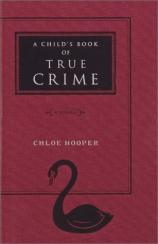Reading Group Guide
Discussion Questions
A Child's Book of True Crime: A Novel

1. As an elementary school teacher, Kate straddles the world of adults and the world of children. How do her personality and behavior reflect this split? How does her version of the Black Swan Point murder story mix the two worlds? Do other characters in the novel have elements of both maturity and childishness?
2. "I liked reading children their stories. And I liked the stories: dogs and cats had magic powers; nasty people suffered slapstick doom. The world seemed manageable, its scale of anarchy to my liking" (p.39). What does Kate's fondness for children's stories illustrate? How does the world within these stories differ from the world she encounters outside the classroom?
3. Compare Kate's version of the Black Swan Point story to what we know of Veronica's version. What are the key differences? What do these differences suggest about the two women? What might Kate's description of Veronica's book suggest about Kate?
4. "Everyone should have one great secret to carry around as a talisman. Then, when people look at you, thinking she's like this, or she's only this, they'll always be wrong" (p. 59). The quote above is from the passage in which Kate is exploring the psychology of Ellie, the young mistress in the Murder at Black Swan Point story. How does Kate's thinking differ from Ellie's? How is it similar?
5. "Children understand tragedy in a way adults are unable to: atom by atom. Untainted by a hundred other learnt horrors, they are haunted for the appropriate length of time. They ask a thousand unanswerable questions. The story stays with them; they dream of it." What does it mean to understand tragedy "atom by atom"? Why are adults unable to do so? Is there something cruel about telling children crime stories, which they will then vividly imagine? Are there elements of cruelty in Kate's nature?
6. "By 1839 most of the indigenous population had died or been driven away. Our local history is the Ur-true crime story, and in volume after volume the bodies pile up" (p. 85). Consider the ways in which the setting -- both geographical and natural -- contributes to the overall effect of the novel. How does the author use the surrounding of a particular scene to enhance the narrative?
7. Discuss the scene in which Kate drives off the road in the old Mercedes and has to seek help from a local man. What makes this scene so unsettling? How does the author achieve such tension? How does this scene relate to the rest of the novel?
8. Images and stories of sex permeate the novel, and so do images and tales of death. What does the author suggest about the relationship between sex -- especially illicit sex -- and violence or death?
9. "It was strange, but despite the Marnes's threats for the first time in a long while I felt totally alive....Fear, like guilt, must have a way of increasing the pixillation of every day life" (p.152). In what ways does Kate seem to cultivate fear and guilt in her own life? Is there an element of masochism in her character?
10. What are the parallels between the story in Murder at Black Swan Point and Kate's own story? Is she justified in her fear and suspicion of Veronica, or has she spooked herself by becoming too engrossed in the Murder at Black Swan Point story?
11. Discuss the scene at the end of the book when Kate visits the Marnes. What did Kate expect to accomplish by confronting Veronica and Thomas? How is she disappointed? How is Kate¹s view of the world and her own life different after the incident?
12. "And I'd decided, in another life, to write a book-length explanation for Lucien: a child's book of true crime. Apparently in Stalinist Russia, blacklisted writers and artists had embedded secret messages in children's literature...disguised as the naive, subversive content was unrecognizable" (p.202). In what ways does Kate disguise her own story by using "the naive"? Is there a sense in which the novel itself is "a child's book of true crime"?
13. "Close your eyes: listen to the sea. You're so near to it -- the cradle and the grave -- even if you never want to die." (p. 211). The ending of the novel encourages us to think about mortality, and about the relationship between the young and the old. What does the author suggest -- here and elsewhere -- about the relationship between youth and death?
A Child's Book of True Crime: A Novel
- Publication Date: March 5, 2002
- Hardcover: 240 pages
- Publisher: Scribner
- ISBN-10: 0743225120
- ISBN-13: 9780743225120






